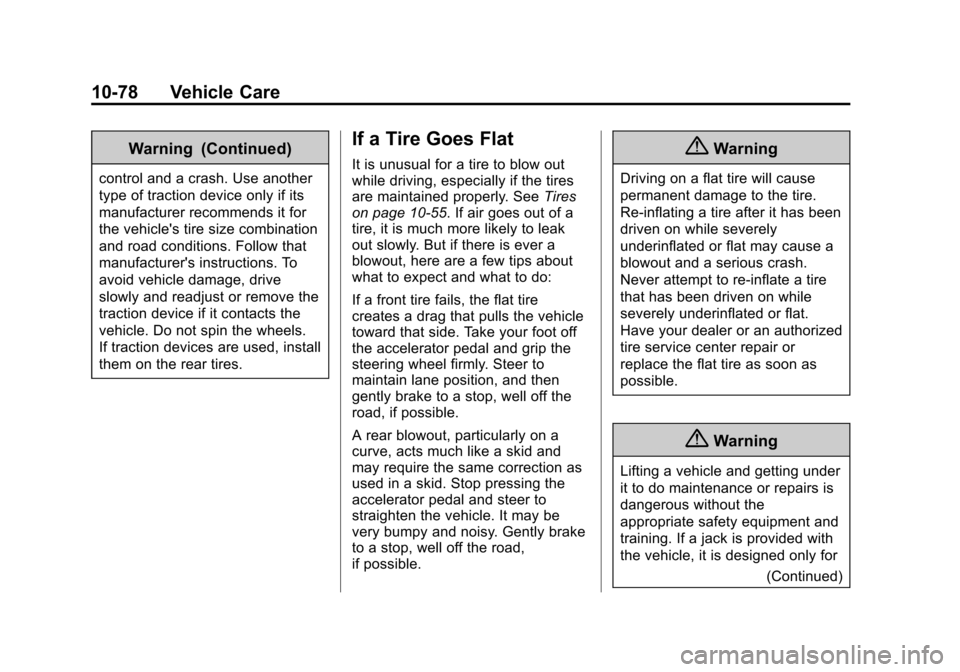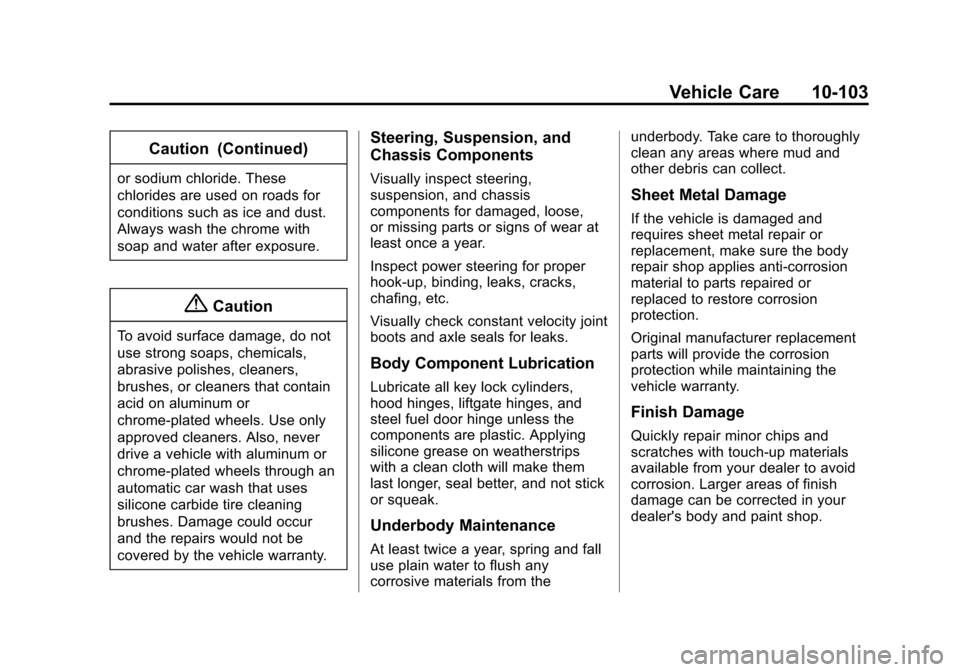2015 CHEVROLET CAMARO steering
[x] Cancel search: steeringPage 268 of 435

Black plate (5,1)Chevrolet Camaro Owner Manual (GMNA-Localizing-U.S./Canada/Mexico-
7695163) - 2015 - crc - 9/4/14
Vehicle Care 10-5
Hood
To open the hood:
1. Pull the release handle belowthe instrument panel to the left of
the steering wheel.
2. Push the secondary hoodrelease to the right. The lever is
near the middle of the hood.
3. Lift the hood.
Before closing the hood, be sure all
filler caps are on properly. Then lift
the hood to relieve pressure. Pull
the hood down on the passenger
side to close it firmly.
Page 270 of 435

Black plate (7,1)Chevrolet Camaro Owner Manual (GMNA-Localizing-U.S./Canada/Mexico-
7695163) - 2015 - crc - 9/4/14
Vehicle Care 10-7
1. Underhood Electrical Center.See Engine Compartment Fuse
Block on page 10-49.
2. Engine Coolant Recovery Bottle and Cap. See Engine Coolant
on page 10-30.
3. Engine Cover on page 10-13.
4. Engine Cooling Fans (Out of View). See Cooling System
(Except ZL1 and Z/28 Engines)
on page 10-25 orCooling
System (ZL1 Engine Only) on
page 10-27 orCooling System
(Intercooler) on page 10-28 or
Cooling System (Z/28 Engine
Only) on page 10-29. 5. Radiator Fill Cap (Out of View).
See Engine Coolant on
page 10-30.
6. Power Steering Reservoir and Cap (Out of View). See Power
Steering Fluid (L99, LS3,
ZL1 and Z/28) on page 10-36 or
Power Steering Fluid (LFX) on
page 10-36.
7. Engine Oil Fill Cap. See Engine
Oil on page 10-15.
8. Engine Oil Dipstick (Out of View). See Engine Oil on
page 10-15.
9. Brake Fluid and Hydraulic Clutch Reservoir (If Equipped with
Manual Transmission). See
Brakes on page 10-38 or
Hydraulic Clutch on page 10-21. 10. Remote Positive (+) Terminal.
SeeBattery on page 10-40.
11. Engine Air Cleaner/Filter
(Except ZL1 and Z/28)) on
page 10-21 orEngine Air
Cleaner/Filter (ZL1 Only) on
page 10-23 orEngine Air
Cleaner/Filter (Z/28 Only) on
page 10-24.
12. Windshield Washer Fluid Reservoir. See Washer Fluid
on page 10-37.
Page 272 of 435

Black plate (9,1)Chevrolet Camaro Owner Manual (GMNA-Localizing-U.S./Canada/Mexico-
7695163) - 2015 - crc - 9/4/14
Vehicle Care 10-9
1. Underhood Electrical Center.See Engine Compartment Fuse
Block on page 10-49.
2. Engine Coolant Recovery Bottle and Cap. See Engine Coolant
on page 10-30.
3. Engine Oil Dipstick. See Engine
Oil on page 10-15.
4. Engine Oil Fill Cap (Out of View). See Engine Oil on
page 10-15.
5. Engine Cover on page 10-13. 6. Engine Cooling Fans (Out of
View). See Cooling System
(Except ZL1 and Z/28 Engines)
on page 10-25 orCooling
System (ZL1 Engine Only) on
page 10-27 orCooling System
(Intercooler) on page 10-28 or
Cooling System (Z/28 Engine
Only) on page 10-29.
7. Radiator Fill Cap (Out of View). See Engine Coolant on
page 10-30.
8. Power Steering Reservoir and Cap (Under Engine Cover) (if
equipped). See Power Steering
Fluid (L99, LS3, ZL1 and Z/28)
on page 10-36 orPower
Steering Fluid (LFX) on
page 10-36. 9. Brake Fluid and Hydraulic Clutch
Reservoir (If Equipped with
Manual Transmission). See
Brakes on page 10-38 or
Hydraulic Clutch on page 10-21.
10. Remote Positive (+) Terminal. SeeBattery on page 10-40.
11. Engine Air Cleaner/Filter
(Except ZL1 and Z/28)) on
page 10-21 orEngine Air
Cleaner/Filter (ZL1 Only) on
page 10-23 orEngine Air
Cleaner/Filter (Z/28 Only) on
page 10-24.
12. Windshield Washer Fluid Reservoir. See Washer Fluid
on page 10-37.
Page 299 of 435

Black plate (36,1)Chevrolet Camaro Owner Manual (GMNA-Localizing-U.S./Canada/Mexico-
7695163) - 2015 - crc - 9/4/14
10-36 Vehicle Care
Warning (Continued)
If you keep driving when the
engine is overheated, the liquids
in it can catch fire. You or others
could be badly burned. Stop the
engine if it overheats, and get out
of the vehicle until the engine
is cool.
If No Steam Is Coming from
the Engine Compartment
If an engine overheat warning is
displayed but no steam can be seen
or heard, the problem may not be
too serious. Sometimes the engine
can get a little too hot when the
vehicle:
.Climbs a long hill on a hot day.
.Stops after high-speed driving.
.Idles for long periods in traffic.
.Tows a trailer.If the overheat warning is displayed
with no sign of steam:
1. Turn the air conditioning off.
2. Turn the heater on to the highest
temperature and to the highest
fan speed. Open the windows as
necessary.
3. When it is safe to do so, pull off the road, shift to P (Park) or
N (Neutral) and let the
engine idle.
If the temperature overheat gauge is
no longer in the overheat zone or an
overheat warning no longer
displays, the vehicle can be driven.
Continue to drive the vehicle slowly
for about 10 minutes. Keep a safe
vehicle distance from the vehicle in
front. If the warning does not come
back on, continue to drive normally
and have the cooling system
checked for proper fill and function.
If the warning continues, pull over,
stop, and park the vehicle
right away. If there is no sign of steam, idle the
engine for three minutes while
parked. If the warning is still
displayed, turn off the engine until it
cools down.
Power Steering Fluid
(L99, LS3, ZL1 and Z/28)
The vehicle has electric power
steering and does not use power
steering fluid.
Power Steering
Fluid (LFX)
The power steering fluid reservoir is
under the engine cover on the driver
side toward the front of the engine
compartment. See
Engine
Compartment Overview on
page 10-6.
Page 300 of 435

Black plate (37,1)Chevrolet Camaro Owner Manual (GMNA-Localizing-U.S./Canada/Mexico-
7695163) - 2015 - crc - 9/4/14
Vehicle Care 10-37
When to Check Power Steering
Fluid
It is not necessary to regularly
check power steering fluid unless
you suspect there is a leak in the
system or an unusual noise is
heard. A fluid loss in this system
could indicate a problem. Have the
system inspected and repaired.
How to Check Power Steering
Fluid
Check the level after the vehicle has
been driven for at least 20 minutes
so the fluid is warm.
To check the power steering fluid:
1. Turn the ignition key to LOCK/OFF and let the engine
compartment cool down.
2. Remove the engine cover. See Engine Cover on page 10-13.
3. Wipe the cap and the top of the reservoir clean.
4. Turn the cap counterclockwise and pull it straight up. 5. Wipe the dipstick with a
clean rag.
6. Replace the cap and completely tighten it.
7. Remove the cap again and look at the fluid level on the dipstick.
When the engine is hot, the level
should be at the hot MAX level.
When the engine is cold, the
fluid level should be between
MIN and MAX on the dipstick.
What to Use
To determine what kind of fluid to
use, see Recommended Fluids and
Lubricants on page 11-12. Always
use the proper fluid.
Washer Fluid
What to Use
When windshield washer fluid is
needed, be sure to read the
manufacturer's instructions before
use. If operating the vehicle in an
area where the temperature can fall
below freezing, use a fluid that has
sufficient protection against
freezing.
Adding Washer Fluid
Open the cap with the washer
symbol on it. Add washer fluid until
the reservoir is full. See Engine
Compartment Overview on
page 10-6 for reservoir location.
Page 315 of 435

Black plate (52,1)Chevrolet Camaro Owner Manual (GMNA-Localizing-U.S./Canada/Mexico-
7695163) - 2015 - crc - 9/4/14
10-52 Vehicle Care
The vehicle may not be equipped
with all of the fuses, relays, and
features shown.Fuses Usage
F1 Discrete Logic Ignition Switch
F2 Diagnostic Link Connector Fuses
Usage
F3 Airbag
F4 Cluster
F5 Heating Ventilation Air Conditioning
Controller Fuses
Usage
F6 Body Control Module 2
F8 Battery
F9 Spare
F10 Spare
F11 Spare
F12 Spare
F13 Display
F14 OnStar
®Universal
Hands-Free Phone
(If Equipped)
F15 Body Control Module 3
F16 Body Control Module 4
F17 Power Outlet 1
F18 Power Outlet 2
F19 Steering Wheel Controls Backlight
F20 Spare
Page 341 of 435

Black plate (78,1)Chevrolet Camaro Owner Manual (GMNA-Localizing-U.S./Canada/Mexico-
7695163) - 2015 - crc - 9/4/14
10-78 Vehicle Care
Warning (Continued)
control and a crash. Use another
type of traction device only if its
manufacturer recommends it for
the vehicle's tire size combination
and road conditions. Follow that
manufacturer's instructions. To
avoid vehicle damage, drive
slowly and readjust or remove the
traction device if it contacts the
vehicle. Do not spin the wheels.
If traction devices are used, install
them on the rear tires.
If a Tire Goes Flat
It is unusual for a tire to blow out
while driving, especially if the tires
are maintained properly. SeeTires
on page 10-55. If air goes out of a
tire, it is much more likely to leak
out slowly. But if there is ever a
blowout, here are a few tips about
what to expect and what to do:
If a front tire fails, the flat tire
creates a drag that pulls the vehicle
toward that side. Take your foot off
the accelerator pedal and grip the
steering wheel firmly. Steer to
maintain lane position, and then
gently brake to a stop, well off the
road, if possible.
A rear blowout, particularly on a
curve, acts much like a skid and
may require the same correction as
used in a skid. Stop pressing the
accelerator pedal and steer to
straighten the vehicle. It may be
very bumpy and noisy. Gently brake
to a stop, well off the road,
if possible.{Warning
Driving on a flat tire will cause
permanent damage to the tire.
Re-inflating a tire after it has been
driven on while severely
underinflated or flat may cause a
blowout and a serious crash.
Never attempt to re-inflate a tire
that has been driven on while
severely underinflated or flat.
Have your dealer or an authorized
tire service center repair or
replace the flat tire as soon as
possible.
{Warning
Lifting a vehicle and getting under
it to do maintenance or repairs is
dangerous without the
appropriate safety equipment and
training. If a jack is provided with
the vehicle, it is designed only for
(Continued)
Page 366 of 435

Black plate (103,1)Chevrolet Camaro Owner Manual (GMNA-Localizing-U.S./Canada/Mexico-
7695163) - 2015 - crc - 9/4/14
Vehicle Care 10-103
Caution (Continued)
or sodium chloride. These
chlorides are used on roads for
conditions such as ice and dust.
Always wash the chrome with
soap and water after exposure.
{Caution
To avoid surface damage, do not
use strong soaps, chemicals,
abrasive polishes, cleaners,
brushes, or cleaners that contain
acid on aluminum or
chrome-plated wheels. Use only
approved cleaners. Also, never
drive a vehicle with aluminum or
chrome-plated wheels through an
automatic car wash that uses
silicone carbide tire cleaning
brushes. Damage could occur
and the repairs would not be
covered by the vehicle warranty.
Steering, Suspension, and
Chassis Components
Visually inspect steering,
suspension, and chassis
components for damaged, loose,
or missing parts or signs of wear at
least once a year.
Inspect power steering for proper
hook-up, binding, leaks, cracks,
chafing, etc.
Visually check constant velocity joint
boots and axle seals for leaks.
Body Component Lubrication
Lubricate all key lock cylinders,
hood hinges, liftgate hinges, and
steel fuel door hinge unless the
components are plastic. Applying
silicone grease on weatherstrips
with a clean cloth will make them
last longer, seal better, and not stick
or squeak.
Underbody Maintenance
At least twice a year, spring and fall
use plain water to flush any
corrosive materials from theunderbody. Take care to thoroughly
clean any areas where mud and
other debris can collect.
Sheet Metal Damage
If the vehicle is damaged and
requires sheet metal repair or
replacement, make sure the body
repair shop applies anti-corrosion
material to parts repaired or
replaced to restore corrosion
protection.
Original manufacturer replacement
parts will provide the corrosion
protection while maintaining the
vehicle warranty.
Finish Damage
Quickly repair minor chips and
scratches with touch-up materials
available from your dealer to avoid
corrosion. Larger areas of finish
damage can be corrected in your
dealer's body and paint shop.